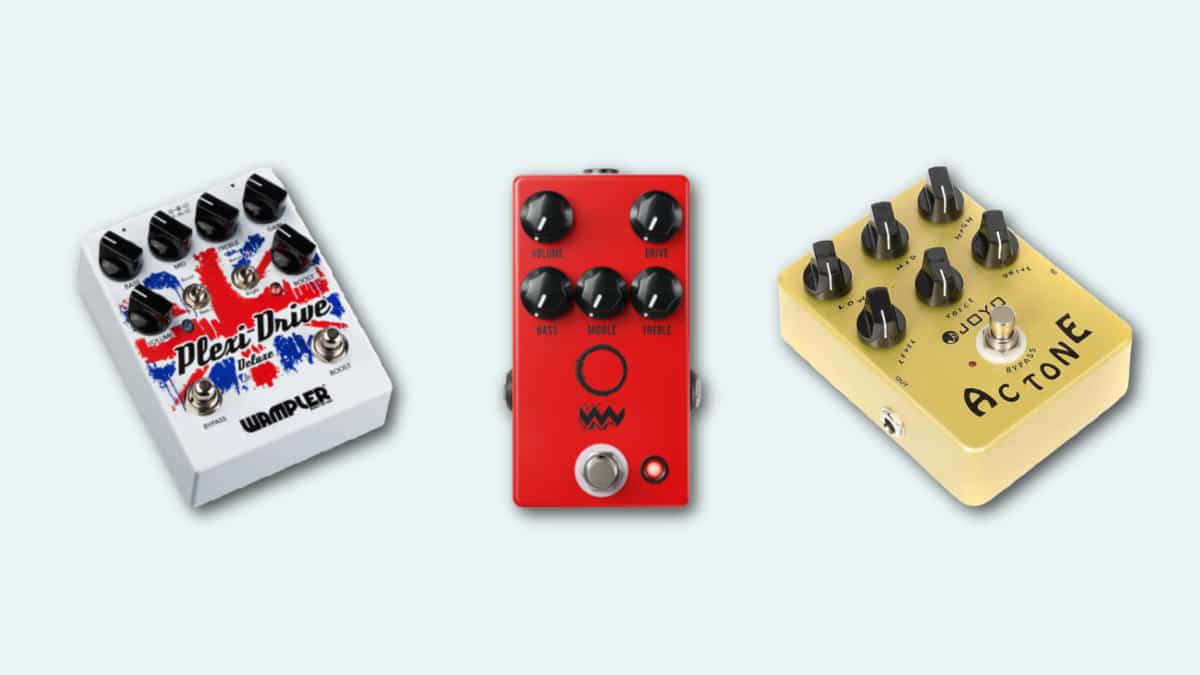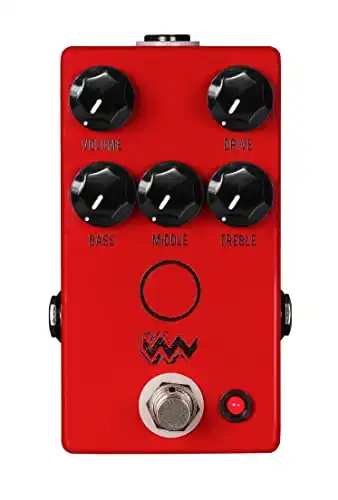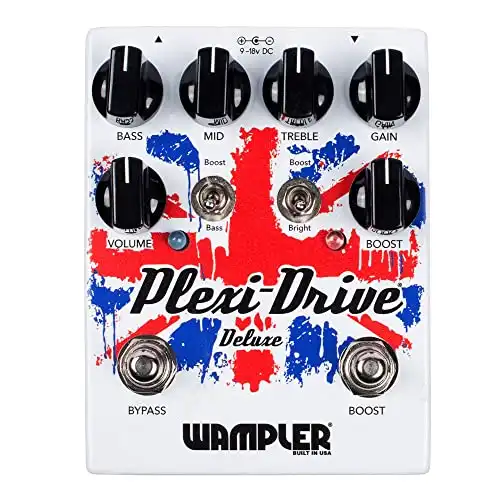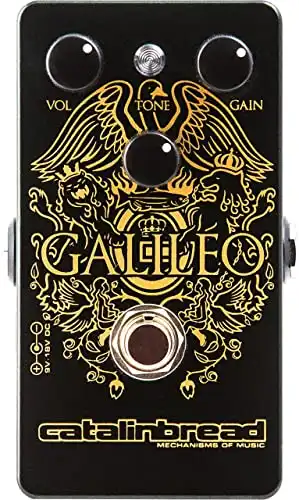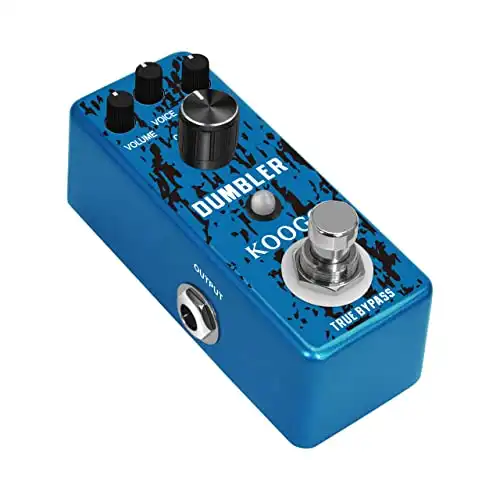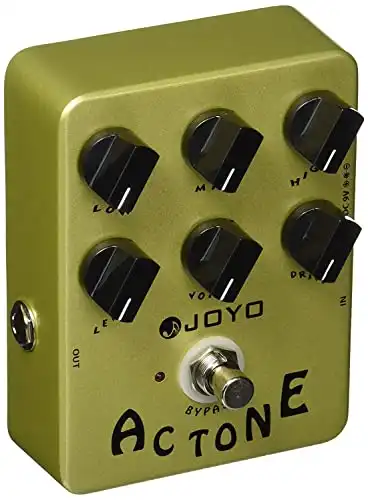Wanna cut to the chase? I went searching for the best amp-in-a-box pedal, and my top pick was the JHS Angry Charlie V3 Distortion Guitar Effects Pedal.
My first guitar cost about $100 and it came with an amp. The noise was terrible and it wasn’t just because of my amateur playing.
As I got better and started earning my own money, I splashed out on a mid-range Ibanez RG. I loved it! The tones that came out of that guitar were beautiful, but not exactly what I wanted.
The problem was, I hadn’t replaced the crummy unbranded amp that came with my first guitar. I overlooked the amp because I wasn’t, at that time, playing to anyone except my dog.
I figured it didn’t really matter. Boy, was I wrong.
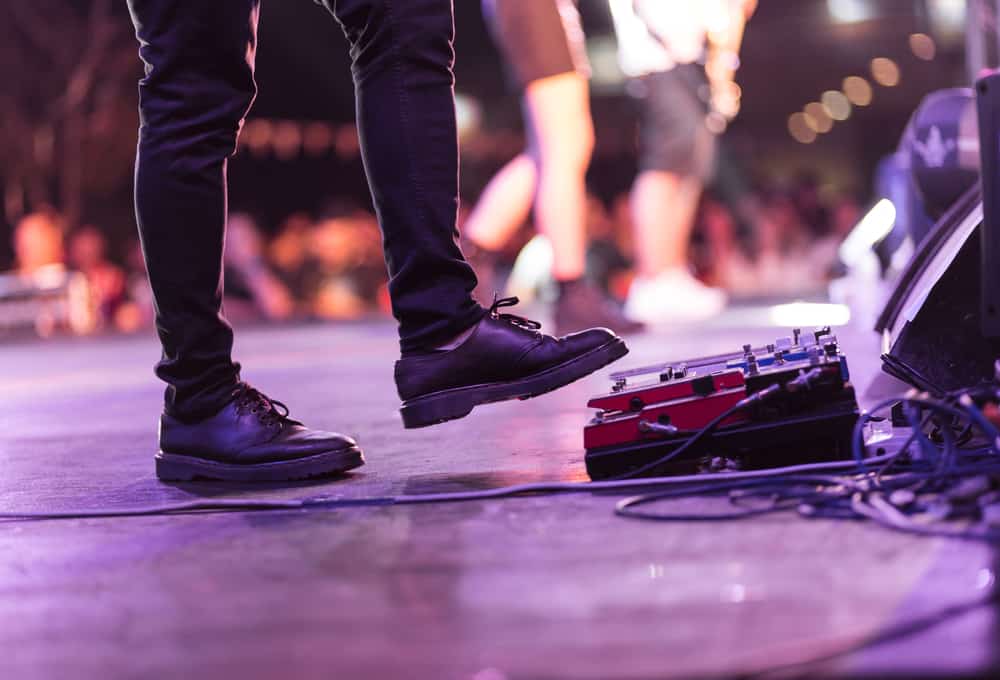
The problem I faced was that to sound like the legends I would need to shell out hundreds or thousands for a great amp.
I loved, still love, Brian May’s sharp, bright tones achieved with the combination of a Vox AC30 amp and his famous Red Special Guitar, but I couldn’t afford the amp.
This is where amp-in-a-box pedals come into play. These pedals help your mid-range amp sound like the amps of legends. They mimic the tones and harmonies of vintage or top-quality amps.
There are so many to choose from nowadays, I thought it would be handy to share some of the best amp-in-a-box pedals around so you too can sound like your guitar heroes!
Top Pick: JHS Angry Charlie V3 Distortion Guitar Effects Pedal
To really understand the beauty of this pedal, you need to understand the influence the Marshall JCM800 had on rock music. This amp was used by the likes of Slash, Mick Mars of Mötley Crüe, Rick Parfitt of Status Quo, and James Hetfield of Metallica.
It was the sound of rock in the eighties.
To contain the deep, rich rock tones of the JCM800 in a pedal is a monumental task, but the JHS Angry Charlie manages it really well.
You can get some really retro-sounding blues tones out of this pedal as well as more gritty and crunchy rock tones.
The versatility of this pedal comes from the controls. You can mimic the sounds of some of the biggest names in rock with a twist of the gain pedal.
If you need to tweak the sound you can adjust the bass, mid and treble tones as well, which is a god-send.
This pedal uses a buffered bypass system which essentially boosts the signal from your guitar to where it should be.
Think about it this way, as the signal from your guitar goes through your pedals and your amps, it slows down and loses itself. This is because it has a lot of wiring to go through. A buffered bypass gives it a little speed boost to get it back to where it should be.
I find that having at least one of these in your pedalboard is a good way to overcome the loss of signal you get from any standard bypass pedals you might have.
What I Like
- Battery or AC powered
- Versatile tones
- Fine-tuning tone controls
- Boosted bypass system
- Creates a Marshall JCM800 sound
What I Don’t Like
- Some people find that the signal and effect is a little bit weak compared to other pedals you might be using.
Editor’s Choice: Wampler Plexi-Drive Deluxe V2 Distortion & Overdrive Guitar Effects Pedal
Hendrix used Marshall Plexi amps at Woodstock to deliver an incredible set.
This pedal can’t, unfortunately, make you into Hendrix overnight. What it can do, is give you the thick, crunchy tones he is famed for.
What I really love about this amp-in-a-box pedal is the massive range it has. Using a bass boost, you can get that thumping bassy tone you’d get with a cabinet set up in a unit a fraction of the size.
The bright boot switch gives you a lighter, more chiming tone which would probably suit a bluesy player.
Wampler has really upped their game with this version of the Plexi-Drive pedal. It doesn’t just allow you to recreate your favorite sounds, it allows you to create your own too.
What I Like
- True bypass
- Bass and bright boost switches
- Fine-tuning tone controls
- Can replicate the Marshall Plexi sound
- Wide tonal range
What I Don’t Like
- Costs a fair bit of money
Best Value: Catalinbread Galileo Booster Guitar Effects Pedal
I had to include this little miracle! The pedal that finally helped me sound like Brian May!
Even if you’re not a big Queen fan, this pedal is great for replicating the Vox AC30 amp. It recreates the bright, jangly, crunchy tone which was iconic in 60s British rock music.
With this pedal, you can control the gain, volume, and overall tone but you can’t fine-tune the individual tones. I don’t mind this because I use the pedal specifically to replicate the Brian May sound.
If you want to try and develop your own sound, then you might want to look at a pedal with a bit more individual control.
My favorite thing about this pedal is the way it boosts the treble tones that Brian May is famous for.
Even though you can’t adjust the treble, mid, and bass notes individually, the tone knob is fairly responsive so you can make some adjustments to your tone.
What I Like
- Recreates that iconic Brian May sound
- Simple three-knob controls
- Battery and external input power options
What I Don’t Like
- Limited personalization range
- Standard bypass system
Runner Up: Koogo Dumbler Pedal Vintage Dumble Amp simulator Effect Overdrive Pedals for Electric Guitar
This is a cheap and cheerful option if you want to play around with amp-in-a-box pedals.
This pedal replicates the sound of the Dumble amp which has been made famous by Clapton and John Mayer. This little pedal allows you to find that soft almost free sound of the Dumble amp.
You have the option to adjust the volume, tone, voice, and gain to develop your sound, which is what the Dumble amp is famous for.
This is a true bypass pedal which is handy if you are going to use it in a chain of pedals. True bypass pedals won’t lose the higher frequencies of your guitar signal like standard bypass pedals do.
I was quite surprised to find a true bypass at such a low price. In my experience cheaper pedals tend to stick with standard bypass systems.
What I Like
- Recreates the Dumble amp sound
- Four band regulator control knobs
- External input power supply
- Good value for the price
- True bypass
What I Don’t Like
- Fairly weak and soft stomp button
- Does seem to put some static in the line
Runner Up: JOYO JF-13 AC Tone Vintage Tube Amplifier Effects Pedal, Analog Circuit, and Bypass
This is another budget option for those of you who want to try out amp-in-a-box pedals.
This recreates the bright, jangling sound of a Vox AC30 amp used by The Beatles and Brian May.
The addition of the bass, mid and treble range controls allows you to make minute adjustments to your sound, which is useful and surprising at this price point.
For the price, this is a good value bit of kit.
It does generate a bit of noise and static particularly when you are playing at lower volumes. I can’t say I’d recommend this to professional players but for hobby guitarists, it works well.
What I Like
- Good value pedal
- Recreates the sound of the Vox AC30
- Warm, retro tone
- Battery or external power input
What I Don’t Like
- Standard bypass function
- Static noise at lower volumes
Best Amp-In-A-Box Pedals [Buying Guide]
Look, I can’t really tell you which is the best amp-in-a-box pedal because they all perform differently.
If you want the warm, fuzzy sound of a Vox amp, then choosing a Plexi pedal is going to be the wrong decision for you. But it doesn’t mean that the Plexi pedal isn’t amazing at its job.
Ultimately, you have to decide what sound you want and pick a pedal that can faithfully recreate that sound.
I have experimented with cheaper pedals when trying to decide which sound and tone I want to create, before upgrading to a more expensive pedal later on. This might be a good option for hobbyists and casual players.
What is an ‘amp-in-a-box pedal?’
An amp-in-a-box pedal isn’t actually an amp. You can’t plug your guitar in and just play, sorry!
What an amp-in-a-box does is replicate the sound of different amps. It lets you change the tone of your guitar so that you can find the meaty, powerful tone that you’d get with, say, a Marshall JCM800, without paying thousands of dollars for the actual amp.
Some amp-in-a-box pedals are designed to sound like particular amps.
Plexi pedals, for example, replicate the Marshall Plexi amp used by Hendrix at Woodstock, while others let you play around with settings to find the tone you love.
To use the pedal, you need to plug it into whatever amp you have, or you can plug the pedal into a preamp and then put the preamp into the speaker system you are using.
Make sure you place it close enough to be able to access it when needed. Of course, the shorter you are, the closer it will need to be. And visa versa.
It’s not as confusing as you might think, to be honest. You just need to plug it into your set up and then you have full control of the sound that comes out of your amp.
This video is great at showing off just what an amp-in-a-box can do. The guitarist plays the same riffs twice, once through a Marshall amp, and once through a different amp via an amp-in-a-box pedal. It is pretty much impossible to tell the difference!
What to look out for when buying an am-in-a-box pedal?
Amp Specific Pedals
Say you fell in love with the light, chiming sound of The Beatles as they played through their Vox AC15 amps and you want to sound just like them! Well, you’re going to want to buy an amp-in-a-box pedal that can mimic that sound.
Some pedals are marketed on the premise that they sound like particular amps. For example, lots of amp-in-a-box pedals have the word Plexi in the name, which tells you that it will mimic the sound of a Marshall Plexi amp.
Other times, you’ll have to do a bit of digging to find the right pedal. I cannot recommend message boards and forums enough!
Check out places like r/guitar pedals on Reddit to hear real-life peoples’ reviews and opinions of different pedals and their sounds.
Controls
Each amp-in-a-box will have a different range of controls. These will help you find the right tone.
Some pedals will allow you to fine-tune the bass, mid and treble ranges as well as the gain and volume. These are great for those of you who are still trying to find your sound.
Other pedals will only allow you to adjust the gain, volume, and overall tone. Usually, these are the pedals that mimic a particular amp or player. If you already know what you want, these pedals are a good choice.
Another control feature to look out for is a true bypass switch. These switches effectively reroute the signals that go through the pedal so they completely skip the part of the pedal that creates the effect.
By actually physically skipping the effect part of the pedal, none of the signal is lost in the wiring. This might not seem like a huge deal, but trust me, it is.
In standard bypass pedals, you can lose some of the higher frequency signals which can make your guitar sound quite flat by the time it gets to the amp.
I will always go for a true bypass pedal because it doesn’t damage the sound when you’re not using the effect.
Power
In terms of power, you have two options, battery-powered or external power supply. Some pedals give you a choice of which power supply you’d like to use, others only accept one kind.
It’s easy enough to figure out what kind of power supply your pedal uses.
If it has a space for a battery, well, duh, it’s battery-powered! If it has a little hole for an AC adapter then it will use external power. If it has both a battery compartment and an AC jack, you have options.
Battery power is fine for playing at home with just one or two pedals. You can also get away with battery power for rehearsals or short shows at a push.
The major issue with batteries is that they die. And trust me, you don’t want your pedal to run out of juice mid-song. It’s embarrassing for everyone.
If you have lots of pedals on your board, you will be forever changing batteries and that is a massive buzz kill, not to mention a big financial drain. These pedals usually use 9V batteries which don’t come cheap!
One good thing about battery-powered pedals is that you aren’t tied to a plug. You have much more flexibility with the positioning of your pedal in your room as well as on your pedalboard.
External power supply pedals are much more reliable. You plug them in, switch them on, and play to your heart’s content. No battery changes, no mid-set battery death.
There are a few problems with external power supplies that you do need to be aware of.
First of all, the wires.
Multiple guitar pedals mean multiple plugs and wires. Nightmare. To get around this you can buy a daisy chain power supply which is one plug with multiple jacks along the line.
However, lots of pedals using one power supply means all your pedals are on the same circuit, which means you can get interference. What you’ll start to hear is that fuzzy, crackling sound almost like there is a bad connection somewhere.
There is no need to panic, however. If you have lots of pedals that you need to use you can get a dedicated power supply.
A dedicated power supply is a box that plugs directly into the plug socket. Your pedals plug into the dedicated power supply and each pedal gets its own circuit supplying electricity. You can say bye-bye to interference and hello to sweet music!
I personally love using dedicated power supplies. I’ve experimented with daisy chains before and while they worked initially, the more pedals I added the more interference I got.
So how does this affect your amp-in-a-box pedal purchase?
Well, if you are adding an amp-in-a-box pedal to an existing set up with multiple pedals, make sure it can use an external power supply. It will be so much easier.
If this is your first and only pedal and you only play at home, you could make do with a battery-powered pedal. Though you might get a bit frustrated if you play a lot and the battery keeps running out.
If you want to find out more about power options for your pedalboard, check out this article. It simplifies all the science stuff around volts and amps and polarity which can affect how your pedals work.
What’s the difference between an amp-in-a-box and an overdrive or distortion pedal?
Ok, to answer this we first need to look at what overdrive and distortion pedals do.
Overdrive pedals are designed to make your guitar sound like you’ve cranked your amp up all the way when you haven’t. It’s safer for the ears and your relationship with your neighbors.
Overdrive isn’t noticeable if you are plucking gently at the strings, but when you start strumming hard, you’ll notice the crunchy sounds coming out of your amp.
Essentially, an overdrive pedal is a sort of booster for your amp. It takes what you’ve got and dials it up to eleven, without the risk of blowing out your amp and your eardrums.
Distortion pedals are all about changing up the sound of your guitar completely. These pedals create that gritty, heavy sound you hear in heavy rock and metal.
Basically, they interfere with or distort, the signals sent from your guitar to the amp. The whole point of distortion pedals is to get in the way and change the sound to something different.
So that leaves amp-in-a-box pedals. They are more concerned with your amp than your guitar. They basically let you play on a midrange amp but make it sound like you are playing on a high-end amp. Think of it as an Instagram filter but for your amp.
You can totally use all three pedals as part of your set up. Overdrive and distortion pedals can be used as and when needed, and your amp-in-a-box pedal can be running at all times if you want.
When you want to kick things into overdrive you can get your overdrive pedal going and instead of it sounding like you’ve cranked an ok-ish amp right up, it will sound like you’ve turned up a top range amp.
If you want to hear the difference between overdrive and distortion pedals for yourself, check out this video. You might want to skip ahead to 2:05 to hear the difference.
Final Thoughts
I hope you found this review of the best amp-in-a-box pedals helpful.
If you’re interested in other types of pedals, you might check out my other reviews, including:
Thanks for visiting!
Let Us Know!
What do you think the best amp-in-a-box pedal is? Let us know if you have any recommendations or suggestions of your own!






